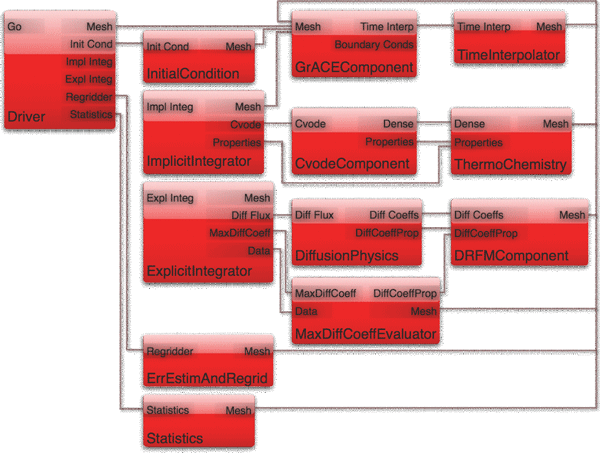Formally, the Common Component Architecture is a specification of an HPC-friendly component model. This specification provides a focus for an extensive research and development effort. The research effort emphasizes understanding how best to utilize and implement component-based software engineering practices in the high-performance scientific computing arena. The development effort creates practical reference implementations and helps scientific software developers use them to create CCA-compliant components and applications.
The CCA specification is expressed as a set of abstract interfaces7 written in the Scientific Interface Definition Language (SIDL). SIDL is used by the Babel language interoperability tool (discussed further below), which implicitly defines bindings to the various languages that Babel supports (currently Fortran 77, Fortran 90, C, C++, Python, and Java).
The primary players in a CCA application are Components that encapsulate a particular piece of software, Ports that define the interfaces between components, and Framework that glue the aforementioned components together and allow them to communicate through the ports that are defined. Figure 1 illustrates how several such components combine together to form a single application. This conceptual model should be familiar to anyone that has used component-based systems before, except that the components explicitly support parallelism and the ports facilitate fine-grained communication of large quantities of data without the copying that is inherent in many such systems.
The core of the CCA specification is the Services interface. This is the primary means by which components interact with the framework, allowing the component to inform the framework of component capabilities and interfaces, and to request access to other services the framework may provide, such as information about connections between itself and other components, or the ability to instantiate and otherwise manipulate other components. The Services interface allows a component to declare two different types of ports, those that it will provide and those that it will use. These ports can also be thought of as callee and caller. These ports make it possible for a CCA framework to effectively mediate connections between components, and allows components to be assembled by another entity (a user through a GUI, a script, or even another component). The CCA component model espouses a minimalist approach, requiring only that components implement a single method/function (called setServices) that establishes contact between the component and the framework.

CCA ports are simply a babel-described interface, and are also identified by a type and name. An optional set of properties associated with each port can describe additional functionality, such as the minimum/maximum number of connections. Components may provide multiple ports and even multiple instances of the same port. In addition to defining the port mechanism, the CCA specification also defines a number of specific ports that are useful in multiple applications, such as the GoPort (for starting an application), parameter ports for communicating basic configuration information to the application, and ports for communicating events to other components. The CCA reuses this port mechanism to export services provided by the framework that allow a component to assemble and manage other components, monitor available components, and watch for application events. Using this mechanism, graphical user interfaces become simply a component that is instantiated in the system and are not tied to the underlying framework. These services also allow dynamic behavior of the application itself, such as swapping components, and provide a mechanism for a hierarchy of components that are assembled at multiple levels of abstraction.






